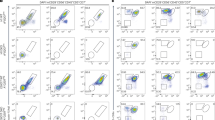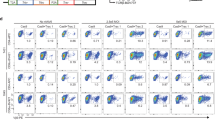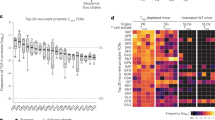Abstract
Many promising targets for T-cell-based cancer immunotherapies are self-antigens. During thymic selection, T cells bearing T cell receptors (TCRs) with high affinity for self-antigen are eliminated. The affinity of the remaining low-avidity TCRs can be improved to increase their antitumor efficacy, but conventional saturation mutagenesis approaches are labor intensive, and the resulting TCRs may be cross-reactive. Here we describe the in vitro maturation and selection of mouse and human T cells on antigen-expressing feeder cells to develop higher-affinity TCRs. The approach takes advantage of natural Tcrb gene rearrangement to generate diversity in the length and composition of CDR3β. In vitro differentiation of progenitors transduced with a known Tcra gene in the presence of antigen drives differentiation of cells with a distinct agonist-selected phenotype. We purified these cells to generate TCRβ chain libraries pre-enriched for target antigen specificity. Several TCRβ chains paired with a transgenic TCRα chain to produce a TCR with higher affinity than the parental TCR for target antigen, without evidence of cross-reactivity.
This is a preview of subscription content, access via your institution
Access options
Access Nature and 54 other Nature Portfolio journals
Get Nature+, our best-value online-access subscription
$29.99 / 30 days
cancel any time
Subscribe to this journal
Receive 12 print issues and online access
$209.00 per year
only $17.42 per issue
Buy this article
- Purchase on Springer Link
- Instant access to full article PDF
Prices may be subject to local taxes which are calculated during checkout






Similar content being viewed by others
References
Kalos, M. et al. T cells with chimeric antigen receptors have potent antitumor effects and can establish memory in patients with advanced leukemia. Sci. Transl. Med. 3, 95ra73 (2011).
Porter, D.L., Levine, B.L., Kalos, M., Bagg, A. & June, C.H. Chimeric antigen receptor-modified T cells in chronic lymphoid leukemia. N. Engl. J. Med. 365, 725–733 (2011).
Kochenderfer, J.N. et al. Eradication of B-lineage cells and regression of lymphoma in a patient treated with autologous T cells genetically engineered to recognize CD19. Blood 116, 4099–4102 (2010).
Chapuis, A.G. et al. Transferred WT1-reactive CD8+ T cells can mediate antileukemic activity and persist in post-transplant patients. Sci. Transl. Med. 5, 174ra27 (2013).
Chapuis, A.G. et al. Transferred melanoma-specific CD8+ T cells persist, mediate tumor regression, and acquire central memory phenotype. Proc. Natl. Acad. Sci. USA 109, 4592–4597 (2012).
Morgan, R.A. et al. Cancer regression in patients after transfer of genetically engineered lymphocytes. Science 314, 126–129 (2006).
Dudley, M.E. et al. Adoptive cell therapy for patients with metastatic melanoma: evaluation of intensive myeloablative chemoradiation preparative regimens. J. Clin. Oncol. 26, 5233–5239 (2008).
Robbins, P.F. et al. Tumor regression in patients with metastatic synovial cell sarcoma and melanoma using genetically engineered lymphocytes reactive with NY-ESO-1. J. Clin. Oncol. 29, 917–924 (2011).
Stromnes, I.M. et al. Abrogation of SRC homology region 2 domain-containing phosphatase 1 in tumor-specific T cells improves efficacy of adoptive immunotherapy by enhancing the effector function and accumulation of short-lived effector T cells in vivo. J. Immunol. 189, 1812–1825 (2012).
Schmitt, T.M., Ragnarsson, G.B. & Greenberg, P.D. T cell receptor gene therapy for cancer. Hum. Gene Ther. 20, 1240–1248 (2009).
Garrido, F., Aptsiauri, N., Doorduijn, E.M., Garcia Lora, A.M. & van Hall, T. The urgent need to recover MHC class I in cancers for effective immunotherapy. Curr. Opin. Immunol. 39, 44–51 (2016).
Udyavar, A., Alli, R., Nguyen, P., Baker, L. & Geiger, T.L. Subtle affinity-enhancing mutations in a myelin oligodendrocyte glycoprotein-specific TCR alter specificity and generate new self-reactivity. J. Immunol. 182, 4439–4447 (2009).
Zhao, Y. et al. High-affinity TCRs generated by phage display provide CD4+ T cells with the ability to recognize and kill tumor cell lines. J. Immunol. 179, 5845–5854 (2007).
Richman, S.A. & Kranz, D.M. Display, engineering, and applications of antigen-specific T cell receptors. Biomol. Eng. 24, 361–373 (2007).
Wucherpfennig, K.W., Gagnon, E., Call, M.J., Huseby, E.S. & Call, M.E. Structural biology of the T-cell receptor: insights into receptor assembly, ligand recognition, and initiation of signaling. Cold Spring Harb. Perspect. Biol. 2, a005140 (2010).
Huseby, E.S., Crawford, F., White, J., Marrack, P. & Kappler, J.W. Interface-disrupting amino acids establish specificity between T cell receptors and complexes of major histocompatibility complex and peptide. Nat. Immunol. 7, 1191–1199 (2006).
Stadinski, B.D. et al. A role for differential variable gene pairing in creating T cell receptors specific for unique major histocompatibility ligands. Immunity 35, 694–704 (2011).
Wang, J.-H. & Reinherz, E.L. The structural basis of αβ T-lineage immune recognition: TCR docking topologies, mechanotransduction, and co-receptor function. Immunol. Rev. 250, 102–119 (2012).
Cameron, B.J. et al. Identification of a Titin-derived HLA-A1-presented peptide as a cross-reactive target for engineered MAGE A3-directed T cells. Sci. Transl. Med. 5, 197ra103 (2013).
Linette, G.P. et al. Cardiovascular toxicity and titin cross-reactivity of affinity-enhanced T cells in myeloma and melanoma. Blood 122, 863–871 (2013).
von Boehmer, H. et al. Pleiotropic changes controlled by the pre-T-cell receptor. Curr. Opin. Immunol. 11, 135–142 (1999).
Pennington, D.J., Silva-Santos, B. & Hayday, A.C. Gammadelta T cell development--having the strength to get there. Curr. Opin. Immunol. 17, 108–115 (2005).
Terrence, K., Pavlovich, C., Matechak, E. & Fowlkes, B. Premature expression of T cell receptor (TCR)αβ suppresses TCRγδ gene rearrangement but permits development of γδ lineage T cells. J. Exp. Med. 192, 537–548 (2000).
Egawa, T., Kreslavsky, T., Littman, D. & von Boehmer, H. Lineage diversion of T cell receptor transgenic thymocytes revealed by lineage fate mapping. PLoS One 3, 1512 (2008).
Baldwin, T.A., Sandau, M.M., Jameson, S.C. & Hogquist, K.A. The timing of TCR alpha expression critically influences T cell development and selection. J. Exp. Med. 202, 111–121 (2005).
von Boehmer, H., Kirberg, J. & Rocha, B. An unusual lineage of α/β T cells that contains autoreactive cells. J. Exp. Med. 174, 1001–1008 (1991).
Schmitt, T.M. & Zúñiga-Pflücker, J.C. Induction of T cell development from hematopoietic progenitor cells by delta-like-1 in vitro. Immunity 17, 749–756 (2002).
Schmitt, T.M. & Zúñiga-Pflücker, J.C. T-cell development, doing it in a dish. Immunol. Rev. 209, 95–102 (2006).
Schmitt, T.M. et al. Induction of T cell development and establishment of T cell competence from embryonic stem cells differentiated in vitro. Nat. Immunol. 5, 410–417 (2004).
Hogquist, K.A., Jameson, S.C. & Bevan, M.J. Strong agonist ligands for the T cell receptor do not mediate positive selection of functional CD8+ T cells. Immunity 3, 79–86 (1995).
Page, D.M., Kane, L.P., Allison, J.P. & Hedrick, S.M. Two signals are required for negative selection of CD4+CD8+ thymocytes. J. Immunol. 151, 1868–1880 (1993).
Schmitt, T.M. et al. Enhanced-affinity murine T-cell receptors for tumor/self-antigens can be safe in gene therapy despite surpassing the threshold for thymic selection. Blood 122, 348–356 (2013).
Chervin, A.S., Aggen, D.H., Raseman, J.M. & Kranz, D.M. Engineering higher affinity T cell receptors using a T cell display system. J. Immunol. Methods 339, 175–184 (2008).
Buckler, A.J., Pelletier, J., Haber, D.A., Glaser, T. & Housman, D.E. Isolation, characterization, and expression of the murine Wilms' tumor gene (WT1) during kidney development. Mol. Cell. Biol. 11, 1707–1712 (1991).
Scharnhorst, V., van der Eb, A.J. & Jochemsen, A.G. WT1 proteins: functions in growth and differentiation. Gene 273, 141–161 (2001).
Holst, J., Vignali, K.M., Burton, A.R. & Vignali, D.A. Rapid analysis of T-cell selection in vivo using T cell–receptor retrogenic mice. Nat. Methods 3, 191–197 (2006).
Smith, T.R.F., Verdeil, G., Marquardt, K. & Sherman, L.A. Contribution of TCR signaling strength to CD8+ T cell peripheral tolerance mechanisms. J. Immunol. 193, 3409–3416 (2014).
Robins, H.S. et al. Comprehensive assessment of T-cell receptor β-chain diversity in αβ T cells. Blood 114, 4099–4107 (2009).
Snauwaert, S. et al. In vitro generation of mature, naive antigen-specific CD8+ T cells with a single T-cell receptor by agonist selection. Leukemia 28, 830–841 (2013).
Van Coppernolle, S. et al. Functionally mature CD4 and CD8 TCRαβ cells are generated in OP9-DL1 cultures from human CD34+ hematopoietic cells. J. Immunol. 183, 4859–4870 (2009).
Liu, B. et al. 2D TCR-pMHC-CD8 kinetics determines T-cell responses in a self-antigen-specific TCR system. Eur. J. Immunol. 44, 239–250 (2014).
Huang, J. et al. The kinetics of two-dimensional TCR and pMHC interactions determine T-cell responsiveness. Nature 464, 932–936 (2010).
Li, Y. et al. Directed evolution of human T-cell receptors with picomolar affinities by phage display. Nat. Biotechnol. 23, 349–354 (2005).
Holler, P.D. et al. In vitro evolution of a T cell receptor with high affinity for peptide/MHC. Proc. Natl. Acad. Sci. USA 97, 5387–5392 (2000).
Jones, L.L., Colf, L.A., Stone, J.D., Garcia, K.C. & Kranz, D.M. Distinct CDR3 conformations in TCRs determine the level of cross-reactivity for diverse antigens, but not the docking orientation. J. Immunol. 181, 6255–6264 (2008).
Hunder, N.N. et al. Treatment of metastatic melanoma with autologous CD4+ T cells against NY-ESO-1. N. Engl. J. Med. 358, 2698–2703 (2008).
Tran, E. et al. Cancer immunotherapy based on mutation-specific CD4+ T cells in a patient with epithelial cancer. Science 344, 641–645 (2014).
Schmitt, T.M., Stromnes, I.M., Chapuis, A.G. & Greenberg, P.D. New strategies in engineering T-cell receptor gene-modified t cells to more effectively target malignancies. Clin. Cancer Res. 21, 5191–5197 (2015).
Stone, J.D. & Kranz, D.M. Role of T cell receptor affinity in the efficacy and specificity of adoptive T cell therapies. Front. Immunol. 4, 244 (2013).
Mehrotra, S. et al. A coreceptor-independent transgenic human TCR mediates anti-tumor and anti-self immunity in mice. J. Immunol. 189, 1627–1638 (2012).
Fujiwara, H. et al. Antileukemia multifunctionality of CD4+ T cells genetically engineered by HLA class I-restricted and WT1-specific T-cell receptor gene transfer. Leukemia 29, 2393–2401 (2015).
Brochet, X., Lefranc, M.-P. & Giudicelli, V. IMGT/V-QUEST: the highly customized and integrated system for IG and TR standardized V-J and V-D-J sequence analysis. Nucleic Acids Res. 36, W503–W508 (2008).
Giudicelli, V., Brochet, X. & Lefranc, M.-P. IMGT/V-QUEST: IMGT standardized analysis of the immunoglobulin (IG) and T cell receptor (TR) nucleotide sequences. Cold Spring Harb. Protoc. 2011, pdb.prot5633 (2011).
Letourneur, F. & Malissen, B. Derivation of a T cell hybridoma variant deprived of functional T cell receptor α and β chain transcripts reveals a nonfunctional α-mRNA of BW5147 origin. Eur.J.Immunol. 19, 2269–2274 (1989).
Acknowledgements
This work was supported by the US National Institutes of Health (NIH) (P01 CA18029-40 and R01 CA033084-32, P.D.G.; NIH CA178844, D.M.K.) and the Guillot Family Fund. T.M.S. is supported by the Jose Carreras International Leukemia Foundation 2013 E.D. Thomas Post-Doctoral Fellowship. We would also like to thank C. Delaney for providing cord blood samples, L. Badenhorst for technical assistance, S. Tan for help with in vivo experiments, and N. Duerkopp for administrative assistance.
Author information
Authors and Affiliations
Contributions
T.M.S. conceptualized, designed and performed the research, interpreted results and wrote the manuscript; D.H.A. contributed to experimental design and developed the 3D-PYY TCR; K.I.-T. performed and optimized experiments; S.O. contributed to experimental design; D.M.K. designed experiments and interpreted results and P.D.G. designed the experiments, assisted in writing the manuscript and supervised the study.
Corresponding author
Ethics declarations
Competing interests
P.D.G. is a co-founder of Juno therapeutics, which is developing T-cell-based immunotherapies including TCR gene therapy. P.D.G. and T.M.S. are co-inventors on a patent application covering the technology described here.
Supplementary information
Supplementary Figures
Supplementary Figures 1–9 (PDF 2923 kb)
Rights and permissions
About this article
Cite this article
Schmitt, T., Aggen, D., Ishida-Tsubota, K. et al. Generation of higher affinity T cell receptors by antigen-driven differentiation of progenitor T cells in vitro. Nat Biotechnol 35, 1188–1195 (2017). https://doi.org/10.1038/nbt.4004
Received:
Accepted:
Published:
Issue Date:
DOI: https://doi.org/10.1038/nbt.4004
This article is cited by
-
Novel insights into TCR-T cell therapy in solid neoplasms: optimizing adoptive immunotherapy
Experimental Hematology & Oncology (2024)
-
Repeated mRNA vaccination sequentially boosts SARS-CoV-2-specific CD8+ T cells in persons with previous COVID-19
Nature Immunology (2024)
-
Anti-BCMA chimeric antigen receptors with fully human heavy-chain-only antigen recognition domains
Nature Communications (2020)
-
Cancer testis antigen Cyclin A1 harbors several HLA-A*02:01-restricted T cell epitopes, which are presented and recognized in vivo
Cancer Immunology, Immunotherapy (2020)
-
Tuning up T-cell receptors
Nature Biotechnology (2017)



